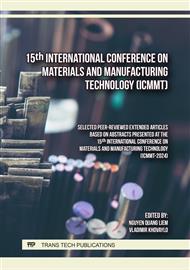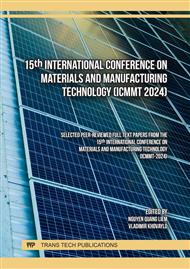[1]
Heinemeyer F., Steckenreiter V., Kiefer F., Peibst R. Hierarchical etching for improved optical front-side properties of monocrystalline Si solar cells. Energy Procedia, 77, (2015), 810-815.
DOI: 10.1016/j.egypro.2015.07.114
Google Scholar
[2]
Razak N.H.A., Amin N., Rahman K.S., Pasupuleti J., Akhtaruzzaman Md., Sopian K., Albaqami M.D., Tighezza A.M., Alothman Z.A., Sillanpää M. Influence of pulsed Nd:YAG laser oscillation energy on silicon wafer texturing for enhanced absorption in photovoltaic cells. Results in Physics, 48, (2023), 106435.
DOI: 10.1016/j.rinp.2023.106435
Google Scholar
[3]
Abdulkadir A., Aziz A.A., Mohd Zamir Pakhuruddin M.Z. Impact of micro-texturization on hybrid micro/nano-textured surface for enhanced broadband light absorption in crystalline silicon for application in photovoltaics. Materials Science in Semiconductor Processing, 105 (2020), 104728.
DOI: 10.1016/j.mssp.2019.104728
Google Scholar
[4]
P. Campbell, M.A. Green. Light trapping properties of pyramidally textured surfaces. J. Appl. Phys., 62, (1987), 243–249
DOI: 10.1063/1.339189
Google Scholar
[5]
Macdonald D. H., Cuevas A., Kerr M. J., Samundsett C., Ruby D., Winderbaum S., Leo A. Texturing industrial multicrystalline silicon solar cells. Solar Energy, 76 (1-3), 277-283, (2004).
DOI: 10.1016/j.solener.2003.08.019
Google Scholar
[6]
Bashera M.K., Hossaina M.K., Uddinb M.J., Akanda M.A.R., Shorowordic K.M. Effect of pyramidal texturization on the optical surface reflectance of monocrystalline photovoltaic silicon wafers. Optik - International Journal for Light and Electron Optics, 172, (2018), 801-811.
DOI: 10.1016/j.ijleo.2018.07.116
Google Scholar
[7]
Wang J., Zhong F., Liu H., Zhao L., Wang W., Xu X., Zhang Y., Yan H. Influence of the textured pyramid size on the performance of silicon heterojunction solar cell. Solar Energy, 221, 114-119, (2021)
DOI: 10.1016/j.solener.2021.04.021
Google Scholar
[8]
Lien S.Y., Yang C.H., Hsua C.H., Lin Y.S., Wang C.C, Wuu D.S. Optimization of textured structure on crystalline silicon wafer for heterojunction solar cell. Materials Chemistry and Physics, 133, (2012), 63–68.
DOI: 10.1016/j.matchemphys.2011.12.052
Google Scholar
[9]
Nanostructure-induced fast texturization of mono-crystalline silicon in low concentration alkaline solution, Jiale Yang, Honglie Shena, Luanhong Sun, Materials Science in Semiconductor Processing, 94, (2019), 1-8.
DOI: 10.1016/j.mssp.2019.01.028
Google Scholar
[10]
Meinel B., Koschwitz T., Heinemann R., Acker, J. (2014). The texturization process during horizontal acidic etching of multi-crystalline silicon wafers. Materials Science in Semiconductor Processing, 26, 695-703, (2014).
DOI: 10.1016/j.mssp.2014.08.047
Google Scholar
[11]
Sethi C., Anand V.K., Walia K., Sood S.C. Optimization of surface reflectance for alkaline textured monocrystalline silicon solar cell. Technol. Int. J. Comput. Sci. Commun. Technol., 5, (2012), 974.
Google Scholar
[12]
Lippold M., Buchholz F., Gondek C., Honeit F., Wefringhaus E., Kroke E. Texturing of SiC-slurry and diamond wire sawn silicon wafers by HF-HNO3-H2SO4 mixtures. Solar Energy Materials and Solar Cells, 127, (2014), 104-110.
DOI: 10.1016/j.solmat.2014.04.006
Google Scholar
[13]
Singh P.K., Kumar R., Lal M., Singh S.N., Das B.K. Effectiveness of anisotropic etching of silicon in aqueous alkaline solutions. Solar Energy Materials and Solar Cells, 70, (2001), 103-113.
DOI: 10.1016/s0927-0248(00)00414-1
Google Scholar
[14]
Seidel H., Csepregi L., Heuberger A., Baumgartel H. Anisotropic etching of crystaline silicon in alkaline solutions. Journal of the Electrochemical Society, 137, 11, 1990, 3613-3631.
DOI: 10.1149/1.2086278
Google Scholar



